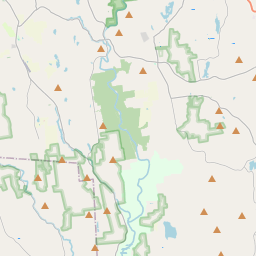The Old Bank
Historical marker location:
129 Main Street, Northampton, Massachusetts
( Marker is at the intersection of Main Street (Massachusetts Route 9) and Gothic Street, on the right when traveling south on Main Street.)







© OpenStreetMap contributors
Loading...
Searching for other points of interest within 10 miles of this location.The Great Boston Fire of 1872 was one of the most destructive fires in American history. It destroyed 65 acres of downtown Boston, including 776 buildings and caused $73.5 million in damage (equivalent to over $1.5 billion today).
About Hampshire County
Hampshire County Timeline
Hampshire County, Massachusetts, has a rich history dating back to colonial times. It was originally inhabited by Native American tribes such as the Pocumtuc and Nipmuc peoples. In 1659, the Massachusetts Bay Colony granted a charter to a group of settlers known as the Hampshire Proprietors, who established the area as a frontier settlement.
During the 18th century, Hampshire County became an important center for agriculture and industry. The fertile Connecticut River Valley allowed for the cultivation of crops such as wheat and tobacco, while mills and factories sprang up along the riverbanks to harness water power. The town of Northampton, in particular, became a hub of activity with its bustling marketplaces and thriving trade.
The 19th century brought significant social and cultural changes to Hampshire County. It became a center for abolitionist activity, with influential figures such as Sojourner Truth and David Ruggles advocating for the end of slavery. The area also gained prominence in the fields of education and the arts, with the establishment of prestigious institutions like Amherst College and Mount Holyoke College.
In the 20th century, Hampshire County continued to evolve as an intellectual and cultural hub. The town of Amherst became renowned for its connection to the literary giants of the time, including Emily Dickinson and Robert Frost. The county also played a key role in the countercultural movements of the 1960s and 1970s, with Hampshire College and the University of Massachusetts Amherst attracting students seeking alternative forms of education.
Today, Hampshire County maintains its reputation as a vibrant and progressive area, known for its beautiful landscapes, top-notch educational institutions, and rich cultural heritage.
During the 18th century, Hampshire County became an important center for agriculture and industry. The fertile Connecticut River Valley allowed for the cultivation of crops such as wheat and tobacco, while mills and factories sprang up along the riverbanks to harness water power. The town of Northampton, in particular, became a hub of activity with its bustling marketplaces and thriving trade.
The 19th century brought significant social and cultural changes to Hampshire County. It became a center for abolitionist activity, with influential figures such as Sojourner Truth and David Ruggles advocating for the end of slavery. The area also gained prominence in the fields of education and the arts, with the establishment of prestigious institutions like Amherst College and Mount Holyoke College.
In the 20th century, Hampshire County continued to evolve as an intellectual and cultural hub. The town of Amherst became renowned for its connection to the literary giants of the time, including Emily Dickinson and Robert Frost. The county also played a key role in the countercultural movements of the 1960s and 1970s, with Hampshire College and the University of Massachusetts Amherst attracting students seeking alternative forms of education.
Today, Hampshire County maintains its reputation as a vibrant and progressive area, known for its beautiful landscapes, top-notch educational institutions, and rich cultural heritage.
Hampshire County Timeline
This timeline provides a condensed summary of the historical journey of Hampshire County, Massachusetts.
- 1662: Hampshire County established as one of three original counties in the Massachusetts Bay Colony.
- 1665: Northampton becomes the county seat.
- 1761: Amherst is incorporated as a separate town.
- 1774: Mount Tom in Holyoke witnesses Shay's Rebellion, a major uprising against perceived economic and civil rights injustices.
- 1821: The Hampshire and Hampden Canal is completed, connecting Northampton to the Connecticut River.
- 1851: Hampshire County's first railroad, the Northampton and Springfield Railroad, commences operations.
- 1861-1865: Hampshire County residents actively participate in the American Civil War.
- 1879: Smith College is founded in Northampton as a private, liberal arts college exclusively for women.
- 1938: The Great New England Hurricane, one of the most destructive hurricanes in U.S. history, causes significant damage in Hampshire County.
- 1974: Hampshire County Courthouse in Northampton is added to the National Register of Historic Places.
- 2004: Hampshire County experiences a devastating flood caused by heavy rain from a tropical storm.